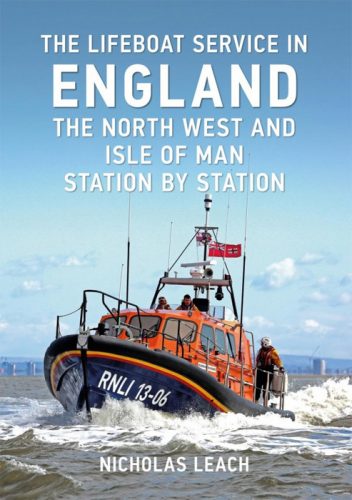By Nicholas Leach
Amberley Press, £15.99
Reviewed by Joe Coventry
The book is a stylish publication, nice to look at and hold. As the title suggests Nicholas Leach is not one to cut corners. The format (in this latest of a series covering the whole of England) is simply set out: historical context, the founding of the RNLI (Royal National Lifeboat Institution), technological developments (from rowing boats to the motor driven rescue crafts now in service) and in Part 2, EVERYTHING you need to know about Lifeboat Stations extant or closed since 1776.
The above describes the objective and material facts of the service but interwoven, particularly in the first half of the book, are accounts of the selfless heroism and valour of individuals and rescue crews alike; life changing disasters that prompted radical re-evaluation of the ethos of the RNLI; lists of honours awarded and the growing community spirit engendered in supporting the growth of the charity.
The Irish Sea can be a cruel place to be in during a storm. Leach relates some of the most famous incidents to have occurred in attempted rescues in graphic detail. These though are the literary “icebergs” of the many times similar crews have had to assemble at short notice, whatever the conditions.
The 1830 rescue of 22 sailors aboard the Steam Packet St George by the Isle of Man Douglas Boat, commanded by the talismanic William Hillary, is heartwarming. He got a gold medal for that. The catastrophic 1886 tragedy of the salvaged 484 ton Three Master, Mexico, with all aboard saved, by the Lytham Boat was paid with a heavy price. That November night the called out St Annes Boat lost all 13 crew and, in the same attempt, 14 of the 16 crew that put out from Southport also perished.
Facts like these cannot fail to stir the emotions, but there is lots more information about why the RNLI is such a much loved national organisation. It was never always so, a couple of times sinking into near ruination through lack of money, foresight or inability to change as fast as wider increased shipping and technological advances; but it got there.
This is a stylish high quality paperback. 128 pages long it packs in 300 illustrations, many of them state of the art digital photographs of today’s breed of enhanced vessels going through their paces and the Stations they operate from.
There are though enough grainy images and postcards from the past, along with images of memorials in honour of those who gave their lives, to satisfy the eye, while the narrative holds the attention.
It is a rewarding and worthwhile read.
